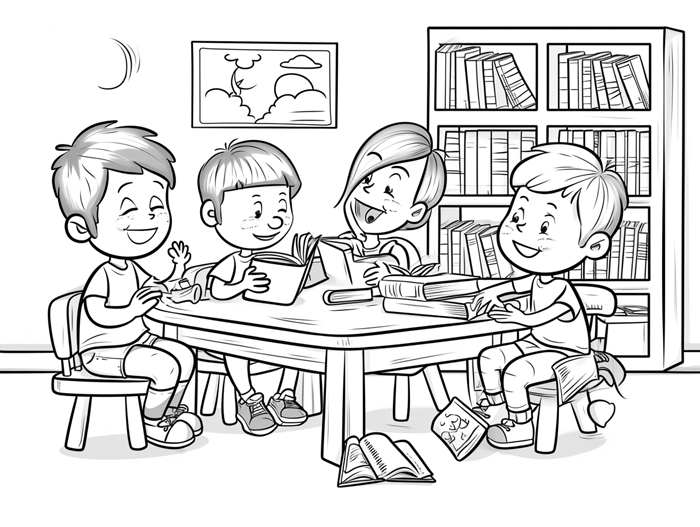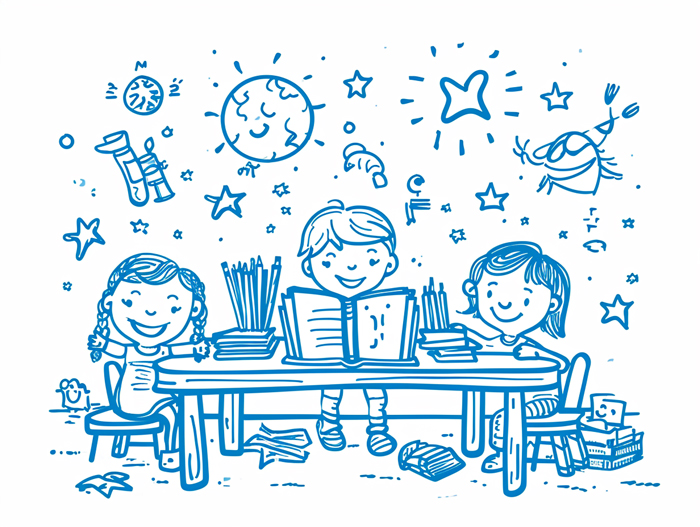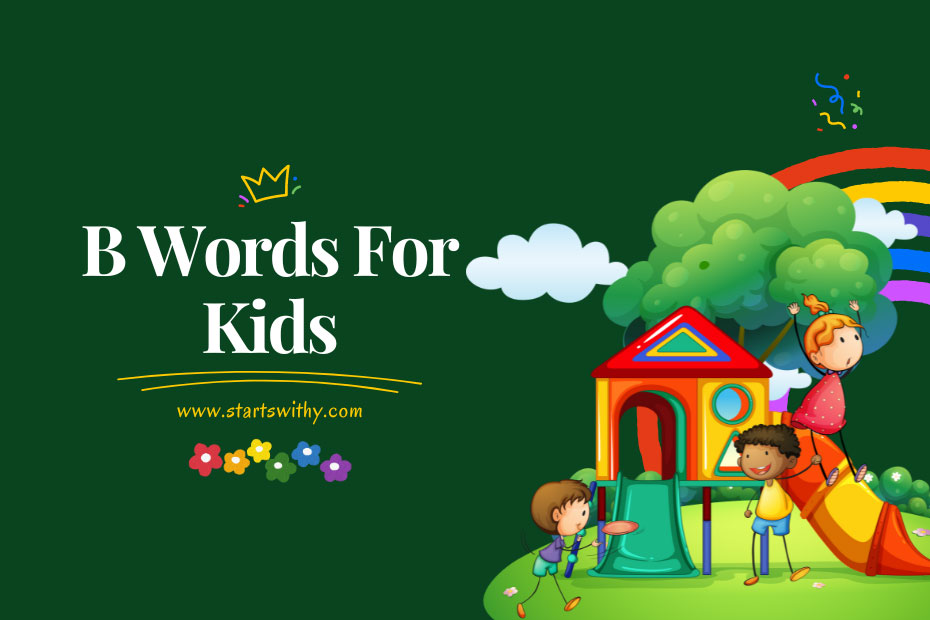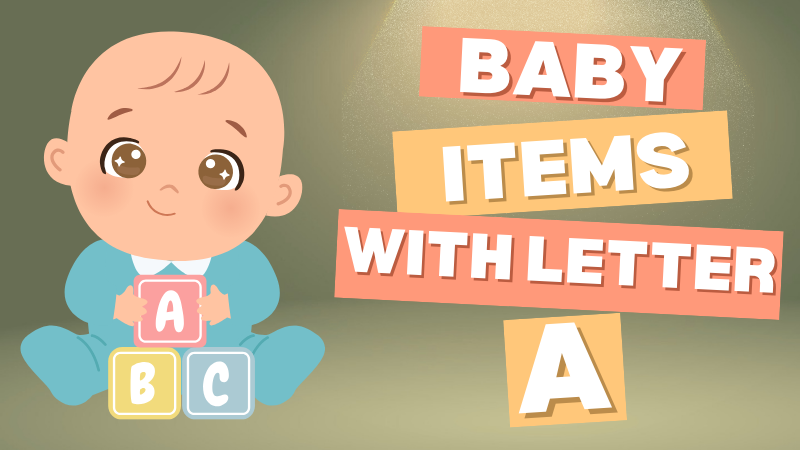Hey there! Are you ready to dive into the wonderful world of B words for kids in Preschool and Kindergarten? Well, you’ve come to the right place! In this article, I’ll be sharing some exciting and educational B words that will not only expand your little one’s vocabulary but also make learning a whole lot of fun. From animals to objects, we’ll explore a wide range of B words that are perfect for young learners. So, let’s get started and discover the magic of B words together!
“B” Words for Kids

As a preschool or kindergarten teacher, I understand the importance of expanding children’s vocabulary in a fun and engaging way. That’s why I’m excited to share some educational “B” words that will make learning exciting for your little ones. Let’s dive into the world of “B” words!
- Bear: Who doesn’t love bears? These majestic creatures are perfect for teaching kids about animals. Talk about different types of bears, such as polar bears and brown bears, and let your students explore their unique characteristics.
- Ball: The classic toy that never goes out of style! Using colorful balls, you can introduce concepts like rolling, bouncing, and catching. Not only will this enhance their motor skills, but it will also teach them about different shapes and sizes.
- Butterfly: The fascinating world of butterflies will captivate your students. Teach them about the life cycle of a butterfly, from the caterpillar stage to the beautiful winged insect. Encourage them to draw and color their own butterflies to reinforce the lesson.
- Bus: Whether it’s a school bus or a city bus, children are always fascinated by these big vehicles. Use toy buses or pictures to teach kids about the different parts of a bus and how important they are for transportation.
- Book: Help your students develop a love for reading by introducing them to books. Explore various genres, from picture books to storybooks, and encourage them to share their favorite stories with each other. Reading not only expands their vocabulary but also improves their imagination and creativity.
- Bell: The sweet sound of a ringing bell will surely capture your students’ attention. Use bells to teach them about sounds and the concept of time. You can also introduce them to different musical instruments that produce bell-like sounds.
- Bird: Birds are perfect for teaching kids about different colors, shapes, and sounds. Encourage them to observe birds in their natural habitat and identify their unique features. You can also teach them bird songs and have fun imitating them together.
Remember, the key to teaching “B” words is to make it interactive and engaging. Use props, pictures, and hands-on activities to bring each word to life. By doing so, you’ll create a memorable learning experience for your young learners.
Preschool Words That Start With B
| Word | Fun Sentence for Kids |
|---|---|
| Ball | Let’s play catch with the colorful ball. |
| Bear | The teddy bear is your cuddly friend. |
| Book | We can read a bedtime story from this book. |
| Banana | Bananas are a yummy snack for preschoolers. |
| Butterfly | Watch the butterfly flutter by in the garden. |
| Blocks | We can build tall towers with these blocks. |
| Bubble | Blow some bubbles and watch them float away. |
| Bunny | The fluffy bunny loves to hop around the yard. |
| Backpack | Put your toys in your backpack for preschool. |
| Boat | Imagine sailing a little boat in a big bathtub. |
| Bell | Ring the bell when it’s time for snack! |
4 Letter Words for Toddlers That Start with B
| Word | Sentence for Kids |
|---|---|
| Ball | Let’s bounce the colorful ball. |
| Bird | Look at the pretty birdie! |
| Bear | Teddy bear is soft and cuddly. |
| Boat | Pretend to sail a toy boat. |
| Book | Time for a bedtime storybook. |
| Baby | Take care of the cute baby. |
| Bell | Ring the bell to make music. |
| Bath | Splish-splash in the bath time. |
| Blue | The sky is so big and blue. |
| Busy | Mommy and Daddy are always busy. |
| Bake | Let’s bake yummy cookies! |
Words That Start With B For Kids
| Word | Fun Sentence for Kids |
|---|---|
| Butterfly | The colorful butterfly flutters in the garden. |
| Bicycle | Riding a bicycle is a fun way to get around. |
| Banana | Bananas are a tasty and healthy snack. |
| Ball | Let’s play with the bouncy ball at the park. |
| Bear | Teddy bear is a cuddly friend for bedtime. |
| Book | Reading a book can take you on adventures. |
| Bubble | Blow some bubbles and watch them float away. |
| Beach | Building sandcastles is so much fun at the beach. |
| Bird | Birds chirp sweetly in the morning. |
| Boat | Imagine sailing a toy boat in a pond. |
| Bubbles | Pop the bubbles and see them disappear! |
Science Words That Start With B
| Word | Fun Sentence for Kids |
|---|---|
| Bacteria | Bacteria are tiny creatures we can’t see without a microscope. |
| Balance | Balance is important when walking on a tightrope. |
| Botany | Botany is the study of plants and how they grow. |
| Beaker | Scientists use a beaker to mix liquids in the lab. |
| Biology | Biology helps us understand how living things work. |
| Butterfly | A butterfly undergoes a transformation called metamorphosis. |
| Battery | Batteries power our toys and gadgets. |
| Black hole | Black holes are mysterious areas in space with strong gravity. |
| Brain | The brain is like a supercomputer in your head. |
| Bioluminescence | Some sea creatures glow in the dark with bioluminescence. |
| Biosphere | The biosphere includes all living things on Earth. |
School Words That Start With B

| Word | Fun Sentence for Kids |
|---|---|
| Backpack | Carry your books and snacks in your backpack. |
| Books | We love to read colorful books at storytime. |
| Blackboard | The teacher writes on the blackboard with chalk. |
| Bus | The school bus takes us to and from school. |
| Bell | The bell rings when it’s time for recess. |
| Board | We can write and draw on the whiteboard. |
| Bookseller | The bookseller sells all kinds of interesting books. |
| Bulletin | The bulletin board displays student artwork. |
| Buttons | Count the buttons on your shirt during math class. |
| Buddy | Find a buddy to work on projects together. |
| Backpacks | Put your backpacks in the cubbies before class. |
Cool Words That Start With B For Kids
| Word | Fun Sentence for Kids |
|---|---|
| Balloon | Let’s blow up a big, colorful balloon! |
| Bubbles | Pop the bubbles and watch them disappear. |
| Bicycle | Riding a bicycle in the park is so cool! |
| Beach | Building sandcastles at the beach is a blast! |
| Banana | Peel a ripe banana and enjoy a tasty snack. |
| Backpack | Your backpack holds all your school treasures. |
| Butterfly | The butterfly’s wings are vibrant and beautiful. |
| Bandana | Wear a bandana as a cool fashion accessory. |
| Binoculars | Use binoculars to see distant objects up close. |
| Blizzard | A blizzard is a wild snowstorm with lots of snow. |
| Boombox | Let’s dance to the music from the boombox! |
| Bamboo | Pandas love to eat bamboo shoots in the forest. |
Positive Words That Start With B for Kids
| Word | Fun Sentence for Kids |
|---|---|
| Brave | Being brave means facing your fears with courage. |
| Bright | The sun makes everything look bright and cheerful. |
| Bliss | Playing with friends can bring a lot of bliss. |
| Buddy | A good buddy is always there to play and share with. |
| Belief | Believe in yourself; you can achieve anything! |
| Best | You’re the best at making everyone smile. |
| Blessing | Having a loving family is a wonderful blessing. |
| Bounce | Bounce with joy when you’re on a trampoline. |
| Brilliant | Your artwork is brilliant; you’re a talented artist. |
| Blossom | Flowers blossom and bloom in the springtime. |
| Blissful | Enjoying ice cream on a sunny day is blissful. |
Importance of Teaching B Words in Preschool and Kindergarten

Developing Vocabulary Skills
As a preschool or kindergarten teacher, I understand the significance of developing vocabulary skills in young learners. A strong vocabulary not only helps children in their communication and language development but also plays a crucial role in their overall academic success.
Teaching “B” words to kids at an early age can have a profound impact on their vocabulary growth. Introducing words like bear, ball, butterfly, bus, book, bell, and bird not only exposes children to new vocabulary but also helps them make connections between the sounds of letters and their corresponding words.
Building Phonemic Awareness
Phonemic awareness, the ability to identify and manipulate sounds in spoken language, is a fundamental skill that lays the foundation for reading and spelling. Teaching “B” words provides an excellent opportunity to develop phonemic awareness in young children.
When children engage with “B” words, they learn to isolate the initial sound /b/ and recognize it in different words. Activities such as brainstorming words that start with the /b/ sound, playing rhyming and word blending games, and listening to stories that feature “B” words can help strengthen their phonemic awareness skills.
By teaching “B” words, we can help children become more confident in their language skills, expand their vocabulary, and enhance their ability to identify and manipulate sounds in spoken language.
Don’t miss the next section where I discuss the importance of promoting letter recognition and early literacy skills in young learners.
Strategies for Teaching “B” Words to Preschool and Kindergarten Kids

Read Alouds and Storytelling
Reading aloud to children is a powerful strategy for teaching “B” words. It helps them develop their vocabulary, build phonemic awareness, and make connections between the sounds of letters and their corresponding words. During read aloud sessions, I engage the kids by using books that feature a variety of “B” words. I emphasize the pronunciation of the words and encourage the children to repeat after me. By incorporating expressive storytelling techniques, I make the learning experience enjoyable and memorable for the kids.
Letter Formation and Handwriting Practice
Teaching letter formation and handwriting practice is essential for reinforcing letter recognition and helping kids develop their motor skills. When introducing “B” words, I guide the children in forming the letter “B” through tracing and copying activities. By including “B” words in handwriting practice exercises, I provide a kinesthetic approach that helps kids remember and recognize the letter. I encourage them to write simple “B” words in sentences to reinforce their understanding of the letter’s sound and shape.
Word Games and Activities
Engaging children in interactive word games and activities is a fun way to reinforce their understanding of “B” words. I incorporate games like “I Spy” or “Word Bingo” where the kids have to identify and match objects or pictures with “B” words. Word puzzles, like crossword puzzles or word searches, are also effective for developing their vocabulary and word recognition skills. By incorporating these activities into their daily routine, I create an enjoyable and immersive learning environment where kids can confidently practice and reinforce their “B” word knowledge.
To summarize the section:
- Read alouds and storytelling help children develop vocabulary and phonemic awareness.
- Letter formation and handwriting practice reinforce letter recognition skills.
- Word games and activities make learning fun and engaging for kids.
Important statistics:
| Strategy | Benefits |
|---|---|
| Read Alouds and Storytelling | – Develops vocabulary and phonemic awareness – Reinforces letter-sound connections |
| Letter Formation and Handwriting Practice | – Reinforces letter recognition skills – Helps develop motor skills |
Recommended B Words for Preschool and Kindergarten Kids
As an experienced teacher, I’ve found that introducing words that start with the letter “B” can be a fun and effective way to expand children’s vocabulary. Below, I’ll share a selection of recommended “B” words that are perfect for preschool and kindergarten kids.
Basic B Words
Basic “B” words are a great starting point for young learners. These words are commonly used and easy to understand. Incorporating them into your lessons can help build a strong foundation for language development. Here are some basic “B” words to get you started:
- Ball: A round object used in various games and sports.
- Book: A collection of written or printed pages bound together.
- Bat: A flying mammal with leathery wings.
- Bear: A large, furry mammal with a distinct snout and claws.
- Block: A solid piece of material used for building or stacking.
Teaching these words can be done in a variety of ways. Flashcards, read-alouds, and hands-on activities are effective methods to engage children and reinforce their understanding of these basic “B” words.
Animal Words Starting with B
What child doesn’t love animals? Incorporating animal words that start with “B” into your lessons can spark excitement and curiosity. Here are some animal words that will captivate your preschool and kindergarten students:
- Butterfly: A beautiful insect with vibrant wings.
- Bunny: A small mammal known for its long ears and fluffy tail.
- Bear: A large mammal often found in forests and mountains.
- Bee: A flying insect known for producing honey.
- Bird: A warm-blooded vertebrate that has feathers and can fly.
By including these animal words in your lessons, you can provide opportunities for students to learn more about the natural world while expanding their vocabulary.
Food Words Starting with B
Introducing food words that start with “B” can make language learning an appetizing experience for young learners. Here are some delicious “B” food words that your students will enjoy:
- Banana: A sweet fruit with a yellow peel.
- Broccoli: A green vegetable known for its nutritional value.
- Bread: A staple food made from dough and baked in an oven.
- Blueberry: A small, round fruit with a blue-violet color.
- Butter: A creamy, spreadable substance made from milk or cream.
Including these food words in your lessons can not only expand vocabulary but also introduce healthy eating habits. Cooking activities and taste tests can help make these food words even more memorable and enjoyable for your students.
As you incorporate these recommended “B” words into your lessons, keep in mind that using a variety of teaching methods, such as read-alouds, hands-on activities, and visual aids, will enhance comprehension and engagement. Remember to create a positive and interactive learning environment that encourages students to explore and expand their vocabulary.
Conclusion
Teaching “B” words to preschool and kindergarten kids can be an exciting and engaging experience. By using strategies such as read alouds, letter formation practice, and word games, educators can help children develop their vocabulary and language skills.
In this article, I have provided a selection of recommended “B” words for preschool and kindergarten kids, including basic words, animal words, and food words. These words can be introduced through flashcards, read-alouds, and hands-on activities, allowing children to actively participate in the learning process.
Creating a positive and interactive learning environment is crucial when teaching “B” words. By incorporating storytelling, encouraging letter formation, and incorporating word games, educators can make learning fun and enjoyable for young learners.
Remember, repetition is key when it comes to teaching new words. By consistently exposing children to “B” words in various contexts, they will gradually become familiar with the sounds and meanings of these words.
Teaching “B” words to preschool and kindergarten kids is an important step in their language development. By implementing the strategies and utilizing the recommended words provided in this article, educators can help children expand their vocabulary and foster a love for learning.

